
Phlox is a genus of 68 species of perennial and annual plants in the family Polemoniaceae. They are found mostly in North America in diverse habitats from alpine tundra to open woodland and prairie. Some flower in spring, others in summer and fall. Flowers may be pale blue, violet, pink, bright red, or white. Many are fragrant.
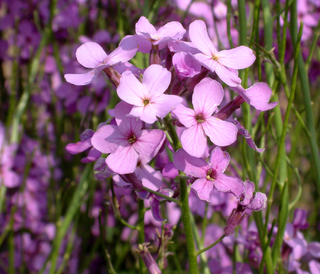
Hesperis matronalis is an herbaceous flowering plant species in the family Brassicaceae. It has numerous common names, including dame's rocket, damask-violet, dame's-violet, dames-wort, dame's gilliflower, night-scented gilliflower, queen's gilliflower, rogue's gilliflower, sweet rocket, and mother-of-the-evening.

Silene nutans is a flowering plant in the genus Silene, most commonly known as Nottingham catchfly.

Neottia ovata, the common twayblade or eggleaf twayblade, is a terrestrial orchid widespread across much of Europe and Asia
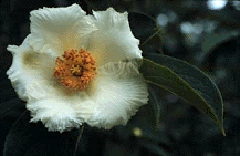
Stewartia ovata, known commonly as mountain camellia, is a small tree native to low to mid-elevations in the southern Appalachian Mountains and nearby regions from Mississippi to Virginia. It is a member of the Theaceae, the tea family.
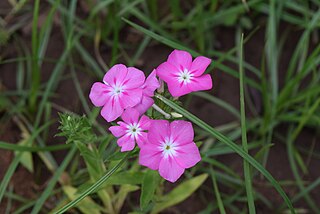
Phlox drummondii is a flowering plant in the genus Phlox of the family Polemoniaceae. Native to Texas, it is also widely distributed in the southeastern United States, especially along public highways. P. drummondii is often used as an ornamental plant. The flowers have a wide range of colours "from white and cream through pinks, lilacs, roses, purples and reds, to almost black".

Phlox subulata the creeping phlox, moss phlox, moss pink or mountain phlox, is a species of flowering plant in the family Polemoniaceae, native to eastern and central USA, and widely cultivated.

Polemonium eximium, the skypilot or showy sky pilot, is a perennial plant in the phlox family (Polemoniaceae) that grows at high altitudes. It is endemic to the Sierra Nevada in California where it grows in the talus of the high mountain slopes.

Goodenia ovata, commonly called the hop goodenia, is a species of flowering plant and is endemic to south-eastern Australia. It is a shrub with sticky, often varnished foliage, toothed egg-shaped to elliptic leaves and racemes or thyrses of yellow flowers.

Gilia cana is a species of flowering plant in the phlox family known by the common name showy gilia. It is native to California and Nevada where it grows in open areas with gravelly and sandy soils, such as desert and rocky slopes. The Mojave Desert range of some subspecies may extend into Arizona.
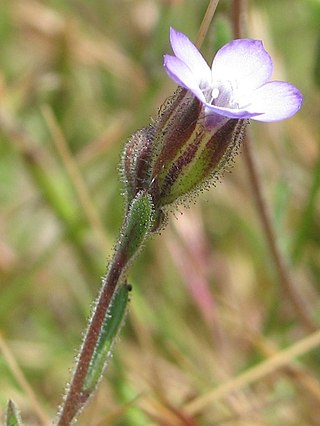
Gilia millefoliata is a species of flowering plant in the phlox family known by the common name manyleaf gilia. It is native to the coastline of Oregon and northern California, where it grows in sand dune habitat.
Navarretia rosulata is a rare species of flowering plant in the phlox family known by the common names San Anselmo navarretia, Marin County navarretia, and Marin County pincushionplant.
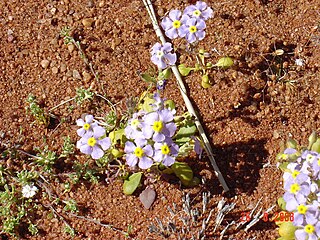
Zaluzianskya is a genus of flowering plants now regarded as a member of the Scrophulariaceae, the figwort family. The genus is endemic to Southern Africa and includes some described sixty species.

Linanthus pungens is a species of flowering plant in the phlox family known by the common names granite prickly-phlox and granite gilia. It is native to western North America from British Columbia to Baja California and east to Montana and New Mexico.
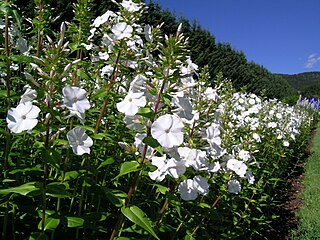
Phlox carolina, the thickleaf phlox, is a species of flowering plant in the family Polemoniaceae. It is an herbaceous perennial growing to 1.2 m (4 ft) tall by 45 cm (18 in) wide, with leaves to 13 cm (5 in) long, and purple or pink flowers in summer. The specific epithet carolina refers to its native habitat in the eastern United States. It grows in woodland edges and openings. Flowers attract bees, hummingbirds, and butterflies.

Crassula ovata, commonly known as jade plant, lucky plant, money plant or money tree, is a succulent plant with small pink or white flowers that is native to the KwaZulu-Natal and Eastern Cape provinces of South Africa, and Mozambique; it is common as a houseplant worldwide. Much of its popularity stems from the low levels of care needed; the jade plant requires little water and can survive in most indoor conditions. It is sometimes referred to as the money tree; however, Pachira aquatica also has this nickname.

Phlox maculata, commonly called meadow phlox, as well as wild sweet William and marsh phlox, is a species of flowering plant in the family Polemoniaceae, native the eastern United States and introduced to eastern Canada. It is a perennial.

A moon garden, also known as a twilight garden, evening garden, night garden, moonlight garden, or dream garden, is a type of garden designed to be enjoyed at dusk and nighttime. Fragrant flowers, light-colored vegetation or blooms that are visible by moonlight, blossoms that open at night instead of day, and plants which attract night pollinators you can hear, are all elements of a moon garden. The different effects produced by moonlight compared to sunlight in human color perception emphasize the colors of certain flowers more than others, bringing out different tones which are not available during daytime or with artificial lights. Night-blooming plants are typically moth, bat or wind pollinated. Planning an evening garden can perform double-duty as a setting for evening entertaining such as barbecues and parties.

Phlox pulchra, commonly known as Wherry's phlox or Alabama phlox, is a perennial species of flowering plant in the family Polemoniacea. It is endemic to Alabama in the United States and historic to nine counties Some occurrences are greatly diminished in size or extirpated, others have not been officially surveyed since the 1980s. Specimens have been vouchered in at least five of these counties. It was originally collected by Dr. Wherry in 1929 in Walker County and thought to be Phlox ovata. Under his cultivation, it was observed to differ as follows: sterile shoot present with partially evergreen leaves, small number of nodes on flowering shoots, large calyx and corolla. He published his findings in the journal Bartonia in 1934. The plant was collected in Walker County by Weezie Smith for Dr. Wherry prior to the publication of his book, The Genus Phlox, in 1955, which details the taxa. The showy, compact flowers bloom in May and June in a color spectrum from bright pink, delicate rose to soft peach and occasionally white. Phlox pulchra, for this reason, has horticulture appeal and is available as “Bibb Pink” and “Eco Pale Moon” cultivars.

Phlox ovata, the Allegheny phlox, mountain phlox, or wideflower phlox, is a species of flowering plant in the family Polemoniaceae, native to the eastern United States. A creeping perennial found in open montane woodlands, its taxonomic history has been marked by nomenclatural issues.



















